- J&J's coronavirus vaccine study halted due to unexplained illness
- NASDAQ notched best day since April on Monday
- US banks start reporting results today, kicking off Q3 earnings season
Key Events
Johnson & Johnson's (NYSE:JNJ) announcement yesterday that it was pausing its trial on a COVID-19 vaccine sent US futures, including for the Dow, S&P, and Russell 2000, as well as European shares into the red on Tuesday. However, NASDAQ futures bucked the trend ahead of Apple's expected announcement of a 5G enabled iPhone after the US markets open later today.
The dollar jumped with yields, weighing on gold. Oil recovered but is caught in the crossfire of conflicting themes.
Global Financial Affairs
Contracts on the S&P 500 fell 0.5%, at the time of writing, after the news from JNJ that its trial has been halted because of an unexplained illness in a participant. However, traders may take the view that such speed bumps are par for the course as vaccine trials progress after last month’s similar hiatus by AstraZeneca (NYSE:AZN), which proved temporary.
Stimulus in the US is looking less likely once again after members of the House were told not to expect action this week as the confirmation hearings for the next Supreme Court judge started on Monday. As well, many Senate Republicans had already rejected the newest proposal from President Trump, indicating the plan was exorbitantly costly.
To that effect, the European Stoxx 600 Index, which slumped with coronavirus-sensitive industries including travel and leisure, cut early losses from 0.6% to 0.1%. From a technical perspective, regional stocks are struggling between two trends.

The pan-European benchmark paused in its uptrend from the Sept. 25 low for the first time in four days, having found resistance at the top of a potential reversal pattern. The 50 DMA crossed above the 200 DMA, triggering a Golden Cross, among the most well known technical signals, demonstrating the conflict between the uptrend since the Sept. 25 low and the downtrend since the July 21 peak.
Japan's Nikkei managed to eke out a gain on Tuesday but Hong Kong's Hang Seng and South Korea's KOSPI were down on news of escalating COVID-19 cases and off-again/on-again stimulus concerns. This was despite data from China which showed that the world's second largest economy expanded 9.9% YoY to $249.8 billion. A 13.2% increase in imports helped to push the trade balance down in September.
Today’s customs data revealed that though exports overall were lower than forecast, they climbed 20.5%, to the US, to $44 billion even with higher US tariffs, but also American goods imported rose 24.5% to $13.2 billion.
However, among regional indices it was Australia's ASX that outperformed, up 1% and hitting a two-month high driven by banks and tech, as local traders placed their faith in the any future US stimulus.
Shares in the US extended an advance on Monday, nearing their highest levels in six weeks. The S&P 500 Index climbed for the fourth straight day, and the NASDAQ registered the biggest jump since April, adding as much as 4.1% but retreating a little to close up 3.09%. Technicals suggest that the tech-heavy index will take on its all-time high shortly.
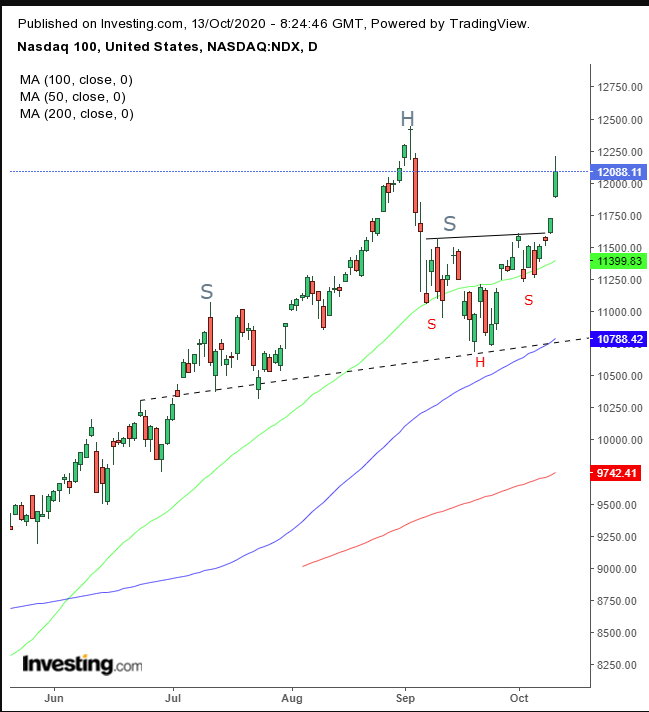
The NASDAQ flipped a H&S top into a smaller H&S bottom.
Amazon (NASDAQ:AMZN) shares surged, on expectations of huge sales numbers during its Prime Day event which starts today and runs for two days.
Apple (NASDAQ:AAPL), which is set to announce the addition of 5G to its new iPhone on Tuesday, saw its share price target increased by RBC Capital Markets to $390 from $345. Twitter (NYSE:TWTR) rallied when Deutsche Bank) increased its price target on the stock from $36 to $56.
Yields, including for the 10-year Treasury note, dropped to 0.75, but remained above the 200 DMA, which has been a proven support for the fourth straight day.
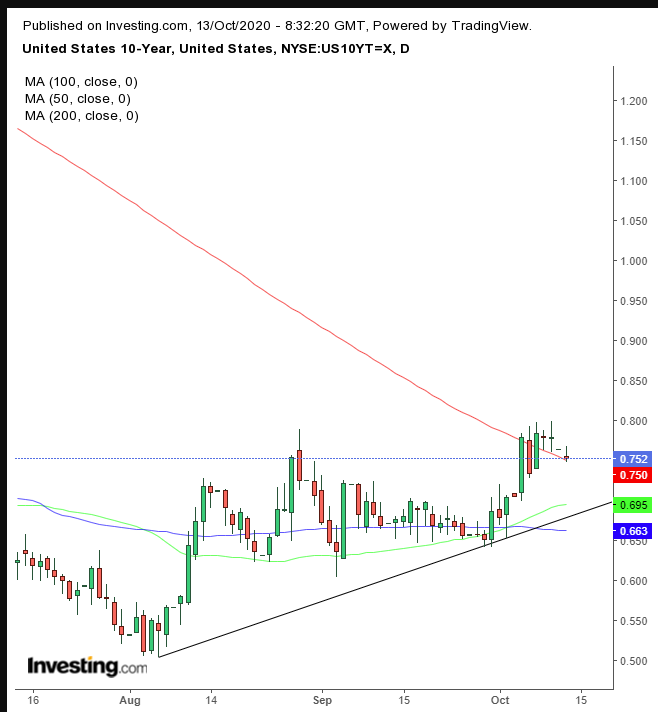
Meanwhile, the 50 DMA, which has been supporting rates since they crossed it on Aug. 12, is climbing toward the 200 DMA, for a potential Golden Cross.
The dollar seemed to find its footing after a four-day selloff.
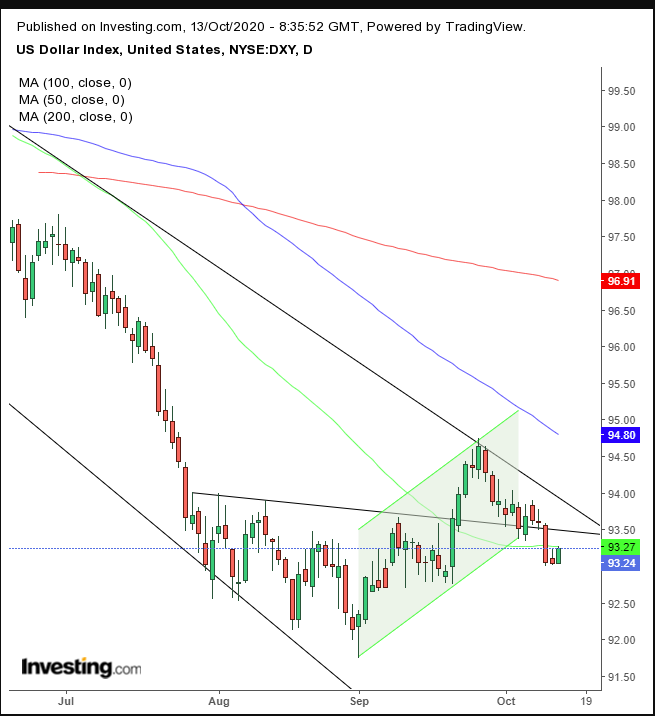
Still, the greenback found resistance at the 50 DMA, after having fallen below the neckline of a would-be bottom. This increases the chances of a resumption of its underlying medium-term downtrend, framed within a falling channel.
Gold was flat, after having rebounded from a 0.7% drop. Perhaps it found support at the bottom of a possible falling wedge, bullish after the medium and long-term uptrend, made particularly so because of the 14% surge within 15 sessions preceding the bullish pattern.
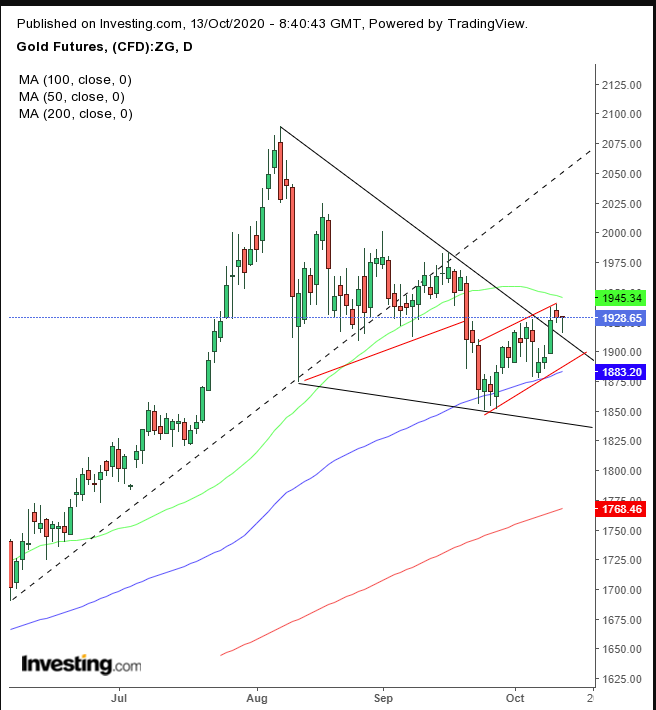
On the other hand, demand has to prove it can absorb all the potential supply represented by the possibly-developing rising flag and preceding bearish symmetrical triangle.
Oil rallied from a slump when workers in the US Gulf headed back to work following Hurricane Delta’s landfall and Libya reopened its biggest field, as China’s crude imports rebounded, ending back-to-back MoM declines.
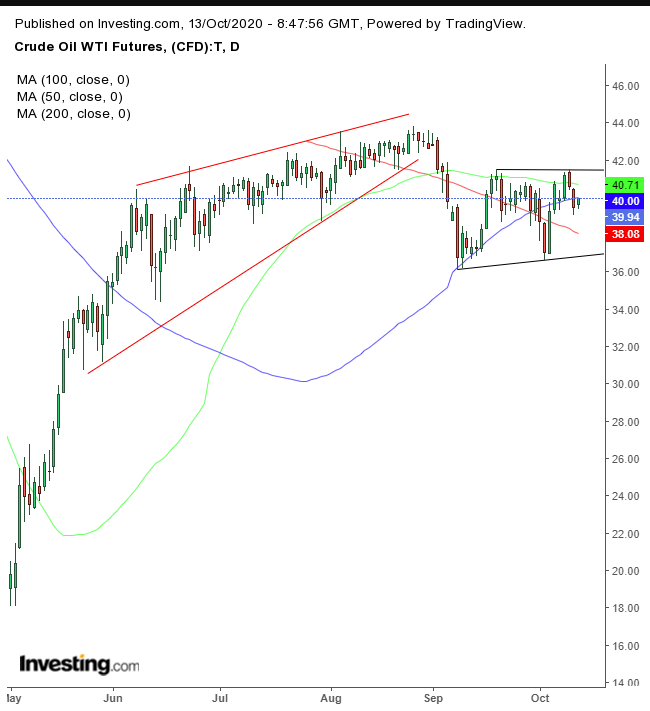
The price of the commodity is trapped within a range, with a bias to a downsized breakout following a bullish rising wedge.
Up Ahead
- Citigroup (NYSE:C) and BlackRock (NYSE:BLK) report earnings on Tuesday.
- Results from Wells Fargo (NYSE:WFC), Bank of America (NYSE:BAC) and Goldman Sachs (NYSE:GS) are due Wednesday.
- Morgan Stanley's (NYSE:MS) earnings release is scheduled for Thursday.
- U.K. Prime Minister Boris Johnson set a deadline of Thursday to thrash out the outline of a European Union trade deal.
- European Central Bank President Christine Lagarde leads off the virtual annual meetings of the International Monetary Fund and the World Bank Group.
Market Moves
Stocks
- Futures on the S&P 500 Index fell 0.6%.
- The Stoxx Europe 600 Index sank 0.4%.
- The MSCI Asia Pacific Index increased 0.1%.
- The MSCI Emerging Markets Index decreased 0.1%.
Currencies
- The Dollar Index pared a 0.25% to 0.1% to 93.14.
- The euro fell 0.3% to $1.1783.
- The British pound sank 0.3% to $1.3029.
- The onshore yuan was little changed at 6.744 per dollar.
- The Japanese yen weakened 0.1% to 105.44 per dollar.
Bonds
- The yield on 10-year Treasuries fell two basis points to 0.75%.
- The yield on two-year Treasuries decreased one basis point to 0.15%.
- Germany’s 10-year yield declined one basis point to -0.55%.
- Britain’s 10-year yield fell one basis point to 0.26%.
- Japan’s 10-year yield decreased less than one basis point to 0.03%.
Commodities
- West Texas Intermediate crude was little changed at $39.44 a barrel.
- Brent crude was little changed at $41.74 a barrel.
- Gold weakened 0.2% to $1,918.46 an ounce.
Which stock should you buy in your very next trade?
AI computing powers are changing the stock market. Investing.com's ProPicks AI includes 6 winning stock portfolios chosen by our advanced AI. In 2024 alone, ProPicks AI identified 2 stocks that surged over 150%, 4 additional stocks that leaped over 30%, and 3 more that climbed over 25%. Which stock will be the next to soar?
Unlock ProPicks AI